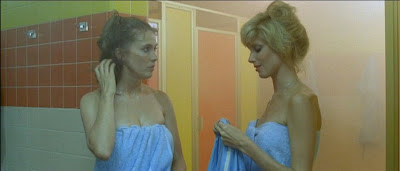
Like I said, it has a story. I didn’t say the story makes much sense. Jacky Reres plays an artist called Lynn Blodgett who paints not-terribly-terrific pictures of scary clowns (and, yes, I know all clowns are scary) which she manages to sell for $8,000 a pop at a local Baltimore gallery. She’s also going through a bitter divorce, bringing up a kid, falling in love with a rollercoaster designer called Tuck, and being stalked by an evil killer wearing clown makeup. Pay attention, folks... This is how you make a slasher movie last an hour and fifty minutes.
So, one day, Lynn is leaving for work when a neighbour informs her that an entire family has been butchered in their beds, oh, two doors down. You can tell it’s serious because there’s some of that yellow crime-scene tape you see on CSI, and no gawkers watching as the paramedics clumsily hoist out a few bodies wrapped in what appear to be blankets. But, hey, Lynn’s already late so she packs herself off to the gallery. And it’s a good thing too, because there’s a rather strange man there who wants to pay her $20,000 to paint his child-molesting dead clown father. Bargain!

Lynn says no... then yes... then worries she might not be able to finish the portrait in the specified three days... and then swans off with her new boyfriend to a disused amusement park for some minor clown-dodging chills. Did I mention she also has a child? It’s OK, I think she forgot too. Little Nicholas is only around when the plot needs him, and Lynn keeps him in a box or something for the rest of the time.
Somewhere amidst all of this riveting entertainment, the clown keeps on a-killin’ and the suspense starts to build. Which brings us to Fear of Clowns’ big fat unfortunate flaw. The clown-faced but shirtless killer is, um... kinda hot. You see, whereas mask + boiler suit = scary, I’m afraid that mask + pecs + abs = something else entirely. This is a problem, as they say in Houston, and I’m sure it even holds true in Baltimore. You simply cannot have a killer who’s both scary and distractingly hot. I mean, you need to know which direction to run in. Granted, said killer may have the face of an evil clown and carry a giant battleaxe, but hotness will always win out, so trying to make your killer both horny and horrifying is like trying to have your cake and

Anyway, Lynn (remember her?) doesn’t have the same problem as I did regarding her greasepaint-sporting stalker. She’s flat-out terrified. So it’s bad news for her but good news for Tuck, who gets to hang around with her a lot, which, in turn, is bad news for Little Nicholas, who has to go back in his box until tea time.
For me, Fear of Clowns peaked around the midpoint, when there’s a simply outrageous (and suspenseful) scene involving an altercation between our hunka honka lethal killer, a hitman who’s unfortunately also dressed as a clown, and a completely innocent clown caught in the red-nosed crossfire. It’s a real circus, believe me. Thereafter, things do build up to a lengthy climax that takes place, credibility-stretchingly enough, in an empty movie theatre, but I’m not sure whether it was the prolonged nature of this set piece that caused me to start getting a bit antsy, or if the movie had simply worn out its welcome by then.
I didn’t exactly juggle for joy, then, when I found out there’s a sequel, Fear of Clowns 2, that actually picks up after the events of this film, utilizing most of the same cast and crew. Still, after reading up on it, I’ve become intrigued enough to want to give it a go. Maybe Fear of Clowns will become the new Phantasm series of continuity-based low budget horror. Or maybe not. Either way, I’d find myself much more predisposed to the whole thing if they’d called this one Someclown’s Watching Me!
Rating: 3/5


 Yet another title this movie goes by
Yet another title this movie goes by








































